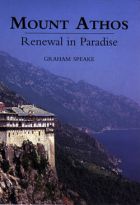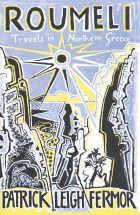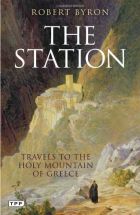Buy or gift a stand-alone digital subscription and get unlimited access to dozens of back issues for just £18.99 / $18.99 a year.
Please register at www.exacteditions.com/digital/cornucopia with your subscriber account number or contact subscriptions@cornucopia.net
Buy a digital subscription Go to the Digital EditionAnthony Bryer reviews ‘Robert Byron’ by James Knox and ‘Mount Athos: Renewal in Paradise’ by Graham Speake
These books are both exceptional, well worth reading together. James Knox’s is a biography of Robert Byron, born in 1905, a tiresome young man (known as a Bright Young Thing in England). Graham Speake’s is a communal biography of the monastic republic of Athos from 963 and its tiresome old men (still called Kalogeroi in Greece).
Speake starts his book with Robert Byron on the marble peak of Mount Athos in 1926, and gives its height as 2,033 metres. Byron estimated it as “a mile and a quarter off the globe”, where “we might, had we wished, have put out a hand to pluck the sky, have palmed away a cup of blue. For that broad illimitable space was now reality, possessing an interesting and unsuspected texture”. This is from Byron’s book on Athos, The Station (1928), the mysterious title of which comes from its last sentence.
In 1958 I could not face the peak of Athos, however described, so I clambered round the mountain with a handy introduction to Fr Nikon (1875-1963), the learned Russian anchorite. Fr Nikon was not on Byron’s visiting list, but he is illustrated in Graham Speake’s book.
If you want an introduction to the Bright Young Things, look up Harold Acton, Alfred Duggan, Anthony Powell or Evelyn Waugh in the index to Knox’s book - and, for girls, all the Mitfords. Byron was the link between them all. He was no relation to the poet (though his name was a useful introduction in Greece), but he was educated beyond his means, so he wrote for a living.
There is curiously little about the Eton beaks and Oxford dons who taught him. Yet Byron was serious about overturning received wisdom. Down with classics! The Renaissance was a false turning. Byzantium was the way and Athos its living survival. This first brought him to the empyrean, a mile and a quarter off the globe.
In 1929 he published The Byzantine Achievement, with its Barmecidal (a favourite Byronesque term) chapter on something called “The Joyous Life”. Apart from an overdose of Oswald Spengler, it reads well because it is conscientiously cribbed from a brief volume in the Home University Library series by Norman Baynes (1877-1961).
In 1930 came The Birth of Western Painting, a handsome tome, perhaps best known by repute, for it came in a limited edition of 650 copies. Using the wall paintings of Athos and Mistra, Byron demonstrated that even Byzantine art might have taken a false turning with the deplorable humanism of a ‘Macedonian School’. It was saved by the ecstatic brilliance of Crete: “The island exhales an atmosphere of grimness and austerity. It could produce nothingÉ which is not unique.” The Cretan peak was Domenikos Theotokopoulos El Greco.
Byron’s bright young text has not worn so well as the accompanying photographs taken by his companion on Athos, David Talbot Rice (1903-1972). Talbot Rice shouldered heavy glass-plate negatives all over the mountain. Sixty years later his widow Tamara gave them to the Barber Institute of the University of Birmingham, where (after reprinting) they were destroyed as a health and fire hazard (see Cornucopia 4, 1993; and for Graham Speake’s superb photographs of Athos today, Cornucopia 15, 1998).
Actually, if Athos assisted the birth of Western painting, it claims the invention of photography too. It was all described in 1458 by the monk Hierotheos in a manuscript that has somehow been mislaid.
Robert Byron’s most influential book is on his search for the birth of Islamic art, The Road to Oxiana (1937), being travels with Christopher Sykes in Persia and Afghanistan. Is it less irritating because its subject is less familiar, or because Byron was better on Timurid tilework than on the ‘Macedonian School’?
He was an even-handed polemicist. In 1939 he took on the British Museum for cleaning the Elgin Marbles and belaboured Appeasers in the Beefsteak Club until Nancy Mitford had to ban him from her bridge parties. His reaction to the colossal Buddhas of Bamian was forthright. “Neither has any artistic value. But one could bear that; it is their negation of sense, the lack of pride in their monstrous flaccid bulk, that sickensÉ Even their material is unbeautifulÉ A lot of monastic navvies were given picks and told to copy some frightful semi-Hellenistic imageÉ The result has not even the dignity of labour.” Yet Byron would have been the first to defend the Buddhas against the Taliban.
What makes him so excellent in parts is the quality of his travelscapes and the fact that he is so funny. An Athonite monk and a Tibetan noble come to life in a droll encounter. Byron’s art history may be portentous - Fr Nikon would have floored him - but he does not trivialise. He was actually writing not for Mayfair but for his mother.
Knox’s compelling biography ends abruptly in 1941, just when you want to turn the page for more. Byron’s ship was torpedoed in the Atlantic.
How would he have turned out? A second Cyril Connolly? A grumpy old Waugh? Perhaps the Bright Young Thing was a Young Fogey after all.
Speake’s communal biography of Athos has an unexpected ending, too, for there is no conclusion to sempiternity. By its millennium in 1963, the old men of the mountain were not so much tiresome as tired. Living Byzantium seemed on its last legs. But the spiritual renewal of Athos since then is a major theme of this prize-winning study.
These books are the ripe fruits of long intimacy with their subjects. James Knox had access to the Byron papers and Graham Speake was received into the Orthodox Church. For fun, I would still take Byron to Athos, too - he smuggled in chicken in aspic from Fortnum & Mason, which comes to the same thing.
Born into penury, he rose to be revered across Europe. Yet the Ottoman Empire’s youngest ever grand vizier is all but forgotten at home. David Barchard charts the dramatic career of the master strategist Âli Pasha
When spring arrives in the high passes of the Taurus Mountains, a dazzling display of flowers comes out to greet it. Story and photographs by Martyn Rix.
SPECIAL OFFER: order three beautiful garden-themed issues, including this one, for only £60. List price £102
Her life is the stuff of fairy tales. Omar Khalidi tells the story of the princess who captivated Cecil Beaton
Xinjiang, formerly known as Chinese Turkestan, is home to some ten million people of Turkic descent. Their culture, language and religious beliefs still owe more to central Asia and the northern steppes than they do to China itself. As distant from the China Sea as it is from the Mediterranean, Xinjiang is a place of wild terrain and extreme climate, surrounded by high mountain ranges. By Christian Tyler
Though Turkish truffles resemble their more famous European cousins in appearance, their fragrance – mellow and delicately fruity – is far milder.
More cookery features
Is this fantastic landscape about to become the new hotspot for wine-lovers? In Cornucopia 31 Kevin Gould heads for the oldest vineyards on earth to find out. Photographs by Frits Meyst





Cornucopia works in partnership with the digital publishing platform Exact Editions to offer individual and institutional subscribers unlimited access to a searchable archive of fascinating back issues and every newly published issue. The digital edition of Cornucopia is available cross-platform on web, iOS and Android and offers a comprehensive search function, allowing the title’s cultural content to be delved into at the touch of a button.
Digital Subscription: £18.99 / $18.99 (1 year)
Subscribe now